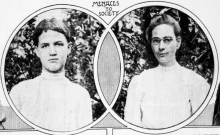“Completely Healthy Children” - The Persistence of Disabled Children and Their Allies During Aktion T4 and the Holocaust
By Wyatt Edwards
In Mikaël Ross’s graphic novel The Thud, the main character Noel, who has a developmental disability and has just arrived at a care facility in Germany, learns from an older woman named Irma about how her brother once told her the story of how the buses came to take disabled children. He was later taken himself and the Nazis killed him at one of Adolf Hitler’s so-called medical centers.



